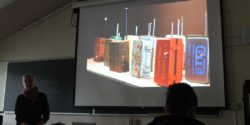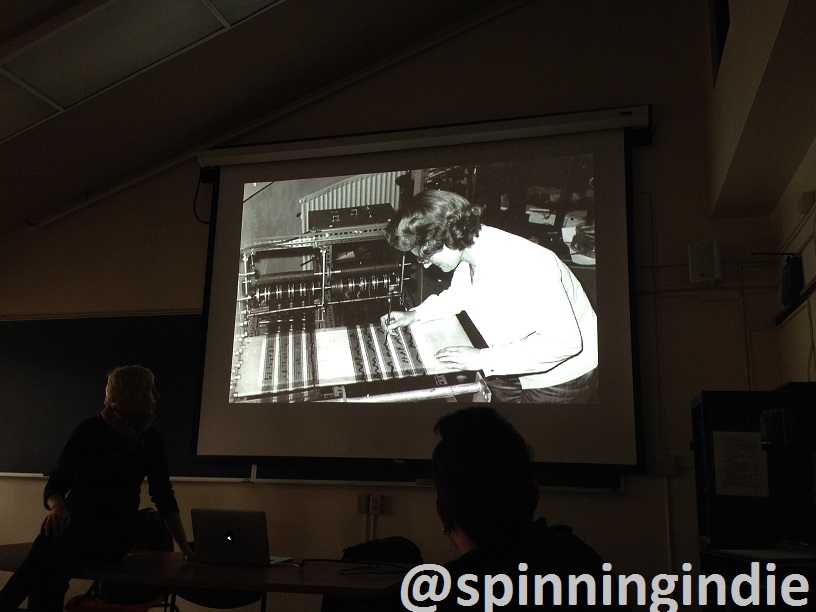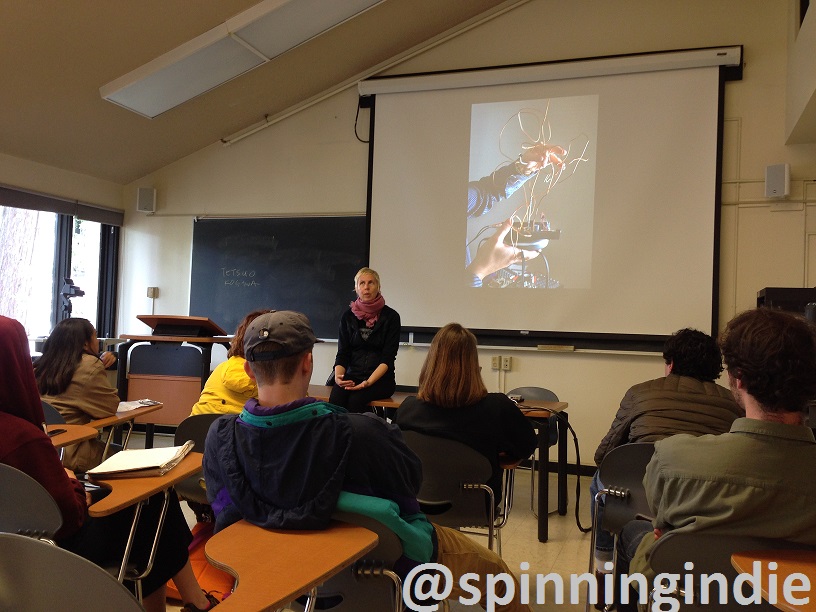As I mentioned in a piece earlier this week, a highlight of last weekend’s UCRN (University of California Radio Network) conference for me was a pair of presentations by sound artist Anna Friz. Also a former college radio DJ and program director, Friz is now Assistant Professor, Film & Digital Media at University of California, Santa Cruz. Read on for my report on her sessions. Also, be sure to listen to this week’s Radio Survivor Podcast. I talk about WTBU’s horrible fire, provide details about speaking opportunities at the fall CBI conference in Philadelphia, and chat about the benefits of college radio getting played on campus.
A Brief History of Radio and Transmission Art
Anna Friz outlined the history of radio and transmission art during a morning talk at UCRN. A radio optimist, Friz proclaimed, “radio will survive the apocalypse.” She’s not only a sound artist, but also has a college radio past, having served as a Program Director at University of British Columbia’s campus-community station CITR in Vancouver, Canada. She explained that radio art stemmed from the question, “What else could we do with the radio?” and pointed out that it is “not always easy listening.” She embraces the DIY opportunities inherent in radio and shared photos of radios crafted out of oat boxes and first aid kit tins, arguing that, “radio is robust stuff and you can build it at home.”
Looking at radio art from a global perspective, Friz said that it’s important to examine how radio began in different countries. She pointed out that in North America, amateurs were the first people making and doing radio, whereas in Europe, state monopolies were first. Coinciding with this, she explained that the avant garde art movement started in Europe at around the same time that radio was in its infancy (1912-1920). Simultaneously, there was an interest in industrial sounds, such as the sounds of cars. That legacy of sound art continued with artists like Antonin Artaud, who was commissioned to do a piece by French national radio in 1947. The ensuing piece, Judgment of God, “horrified” the producers with its “visceral” ranting full of screaming and hissing. While Friz calls it “great stuff,” the powers that be in the 1940s decided to suppress it until 1964. When Judgment of God was eventually played it still caused an “uproar” and was “shocking to a lot of people,” according to Friz.
In addition to the sort of radio art crafted by Artaud, another piece of sound history relates to radio studios, where tools like reel-to-reel tape allowed for the use of the “studio as an instrument.” Sound art pioneer Daphne Oram was the co-founder of the BBC Radiophonic Workshop and developed oramics, a process in which visual scores were turned into audible sounds. Others, like Gregory Whitehead, created experimental sounds for radio. Whitehead did “scream studies,” asking people to leaving screaming messages onto an answering machine. He then crafted radio shows made up of these screams.
“Radio can also be an instrument,” according to Friz. She pointed out that instruments like the theremin (which she describes as the first electronic instrument) and the ondes Martenot, which were both invented by radio operators and both utilize radio technology. Other artists have used radio transmitters in their work. In the 1980s Tetsuo Kogawa built tiny 1 or 2 watt transmitters that he would perform with, using them to create radio silence and interference. Today, sound artists like Friz are doing a wide variety of projects that utilize collections of physical radios, pirate radio transmissions, unusual antennas, and pieces that work to pick up natural radio frequencies.
College Radio Graveyards as Fertile Place for Experimentation
While at campus-community radio station CITR in the late 1990s, Friz was involved with starting up an on-air tradition in which the station plays 24 hours of radio art. She described it as a “technical shake-up” in which DJs were asked to make all the sounds for their shows. She said that it was “a really great thing to do for the station,” and encouraged the UCRN attendees to consider doing similar projects at their college radio stations.
Friz argued that, “you have this incredible resource” and specifically mentioned “overnight” or the graveyard shift as perfect for experimentation. “The night is the most special, interesting time,” she added, calling it a “fertile place” and an “opportunity” for DJ freedom. Having designed overnight radio programs, she gave a lot of credit to listeners, saying, “your listeners are more experimental than you think.” In her afternoon session (which focused more on Friz’s current radio projects), she elaborated, saying that the listening “audience is the most open” late at night. She described a 4am tape loop show in Vancouver that was well-loved by local garbage collectors, who would often call in. Reflecting on the experimental sounds and sleepy haze during late night, she opined, “that kind of altered state…is so special.”
The benefits to station members are huge too. Friz explained that radio art projects often get “volunteers more involved with sound production,” making for a more engaged and more creative group of DJs.
I couldn’t agree more.
I’d love to hear if your station is doing experimental projects or it is has shows devoted to radio art. What do your DJs and listeners enjoy about these programs?
College Radio Day Vinylthon Tomorrow
Coinciding with Record Store Day, more than 40 college radio stations will be playing vinyl records on Saturday, April 16th. College Radio Day came up with the idea for the Vinylthon and is encouraging stations to play at least one hour of all-vinyl programming. For some stations this is a novelty, whereas for others it will be a typical day of programming.
A Look at Boston University’s College Radio Station WTBU
Especially in light of the recent fire, it’s a treat to look at this student-crafted short film of the Boston University college radio station.
More U.S. College Radio News
KSSU Celebrates 25 Years as Sac State’s Scrappy Student-Run Radio Station (Sacramento News & Review)
Making the Case for More Student Media Funding (Grand Valley Lanthorn)
Verge Campus Playlists from the Lion (Verge Campus)
Tennessee AP Announces 2016 College Journalism Winners (Chattanooga Times Free Press)
Radiothon Supports College Radio Station WHFR (Dearborn Press & Guide)
DePauw Student Media Hosts Live Town Hall with President-Elect (DePauw University)
Campus Radio Station and a College Prank at Presbyterian Junior College Radio Station (Fay Observer)
Lincoln College Station WLNX Wins IBS Award (Lincoln Courier)
International College Radio News in Canada, UK, and India
CITR and CJSF to Broadcast Live from Vancouver Record Stores on Record Store Day (CITR)
Radio 1 to Air Student Radio Curated Show (Complete Music Update)
How You Could Get a Student Radio Playlist Show on BBC1 Radio (audioBoom)
Memories of a Student Station – DCUfm (Radio Today)
Core Radio Cambridge Will Be Added to Local DAB Multiplex (Radio Magazine)
Community Radio Experience Empowers Girl Students in India (The Statesman)





